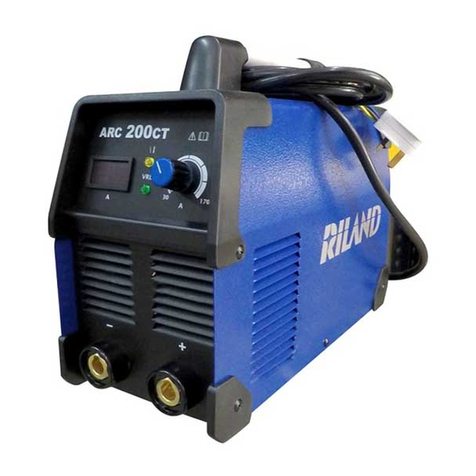8
della torcia
NB: non debbono essere cortocircuitati.
AI - Tappo.
3.5.2 Accendere la macchina.
Non toccare parti sotto tensione e i morsetti di uscita quan-
do l'apparecchio è alimentato.
Alla prima accensione della macchina selezionare il modo
mediante il pulsante Ae i parametri di saldatura mediante il
tasto Re la manopola Ocome indicato al paragrafo 3.2..
Il flusso di gas inerte deve essere regolato ad un valore (in litri
al minuto) di circa 6 volte il diametro dell'elettrodo.
Se si usano accessori tipo il gas-lens la portata di gas può
essere ridotta a circa 3 volte il diametro dell'elettrodo. Il dia-
metro dell'ugello ceramico deve avere un diametro da 4 a 6
volte il diametro dell'elettrodo.
Normalmente il gas più usato è l'ARGON perché ha un costo
minore rispetto agli altri gas inerti, ma possono essere usate
anche miscele di ARGON con un massimo del 2% IDRO-
GENO per la saldatura dell'acciaio inossidabile e ELIO o
miscele di ARGON-ELIO per la saldatura del rame. Queste
miscele aumentano il calore il calore dell'arco in saldatura
ma sono molto più costose. Se si usa gas ELIO aumentare
litri al minuto fino a 10 volte il diametro dell'elettrodo (Es. dia-
metro 1,6 x10= 16 lt/min di Elio).
Usare vetri di protezione D.I.N. 10 fino a 75A e D.I.N. 11 da
75A in poi.
3.6. MEMORIZZAZIONE
E' possibile memorizzare solo dopo avere saldato.
Il pulsante Q, premuto brevemente, effettua una scelta;
premuto per un tempo maggiore di 3 secondi, effettua
una memorizzazione.
Ad ogni accensione, la macchina presenta sempre l'ulti-
ma condizione utilizzata in saldatura.
3.6.1. Memorizzare i dati del programma PL
Utilizzando la macchina per la prima volta
Alla accensione della macchina il display visualizza la sigla
PL questa, dopo 5, scompare e viene visualizzata una cor-
rente di lavoro. Seguire le indicazioni dei paragrafi 3.2 e 3.5
quindi, per memorizzare i dati nel programma P01, proce-
dere nel seguente modo:
· Premere brevemente il pulsante Q(mem+mem-) compa-
rirà la scritta P01 lampeggiante.
· Premere il pulsante Qper un tempo maggiore di 3 secondi
fino a che la sigla P01 smetta di lampeggiare, a questo
punto la memorizzazione è avvenuta.
· Ovviamente se invece di memorizzare nel programma P01
si vuole memorizzare in un programma diverso si premerà il
pulsante Qin maniera breve tante volte quante necessarie
per visualizzare il programma desiderato. Alla riaccensione
della macchina viene visualizzato P01.
IL PULSANTE Q PREMUTO BREVEMENTE EFFETTUA
UNA SCELTA, PREMUTO PER UN TEMPO MAGGIORE
DI 3 SECONDI EFFETTUA UNA MEMORIZZAZIONE.
3.6.2. Memorizzare da un programma libero
L'operatore può modificare e memorizzare un programma
scelto procedendo nel seguente modo:
· Premere il pulsante Qin modo breve e scegliere il numero
di programma desiderato.
I programmi liberi hanno la sigla lampeggiante.
Premere il pulsante AL e scegliere il procedimento di salda-
tura e con il pulsante Ascegliere il modo (paragrafo 3.1).
· Girare la manopola Oed impostare la corrente di saldatura.
Se è stato scelto il procedimento TIG, attivare il led V(post
gas) tramite il pulsante Re regolare tramite la manopola Oil
valore desiderato (paragrafo 3.1.)
Se dopo queste regolazioni, necessarie per saldare, si
vogliono regolare i tempi di "slope" o altro agire come
descritto al paragrafo 3.1.
Eseguire una saldatura anche breve e decidere dove
memorizzare
Per memorizzare nel programma scelto precedentemente,
premere il pulsante Qper più di 3 secondi fino a che il nume-
ro smette di lampeggiare.
Per memorizzare in un programma diverso, fare la scelta
premendo brevemente il pulsante Qquindi premere il pul-
sante Qper più di 3 secondi.
3.6.3 Memorizzare da un programma memorizzato
Partendo da un programma già memorizzato l'operatore
può modificare i dati in memoria per aggiornare il program-
ma stesso o per trovare nuovi parametri da memorizzare in
un altro programma.
3.6.3.1 Aggiornare
· Dopo avere acceso la macchina selezionare i parametri da
modificare e modificarli.
· Eseguire una saldatura anche breve.
· Premere per un tempo maggiore di 3 secondi il tasto Qfino
alla conferma della memorizzazione (sigla del programma da
lampeggiante a continua).
3.6.3.2 Memorizzare in un nuovo programma
· Dopo avere acceso la macchina selezionare i parametri da
modificare e modificarli.
· Eseguire una saldatura anche breve.
· Premere brevemente il selettore Qfino alla visualizzazione
del programma da Voi desiderato.
· Premere di continuo il tasto Qfino alla conferma della
memorizzazione ( sigla del programma da lampeggiante a
continua).
4 COMANDI A DISTANZA
Per la regolazione della corrente di saldatura a questa salda-
trice possono essere connessi i seguenti comandi a distanza:
Art.1260 Torcia TIG solo pulsante.(raffreddamento ad aria).
Art.1256 Torcia TIG solo pulsante.(raffreddamento ad acqua).
Art.1262 Torcia TIG UP/DOWN.(raffreddamento ad aria)
Art.1258 Torcia TIG UP/DOWN.(raffreddamento ad acqua)
Art. 193 Comando a pedale (usato in saldatura TIG)
Art 1192+Art 187 (usato in saldatura MMA)
Art. 1180 Connessione per collegare contemporaneamente
la torcia e il comando a pedale. Con questo accessorio l’Art.
193 può essere utilizzato in qualsiasi modo di saldatura TIG.
I comandi che includono un potenziometro regolano la
corrente di saldatura dal minimo fino alla massima cor-
rente impostata con la manopola O.
I comandi con logica UP/DOWN regolano dal minimo al
massimo la corrente di saldatura.
Le regolazioni dei comandi a distanza sono sempre attive nel
programma PL mentre in un programma memorizzato non
lo sono.






























